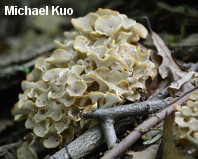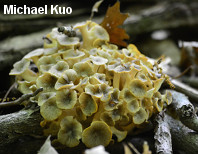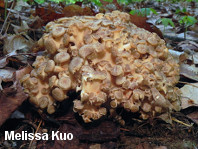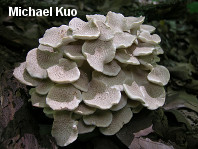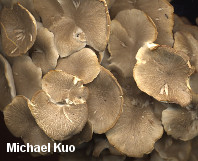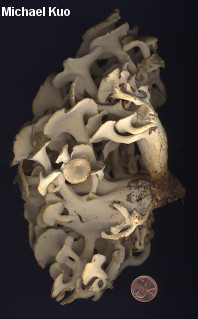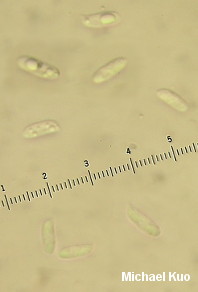| Major Groups > Polypores > Stemmed, Pale-Fleshed > Polyporus umbellatus |

|
Polyporus umbellatus [ Basidiomycota > Polyporales > Polyporaceae > Polyporus . . . ] by Michael Kuo Polyporus umbellatus is a "butt rot" that fruits terrestrially, near the bases and roots of hardwoods across northern North America. It is apparently fairly rare on our continent, and is encountered far less frequently than the somewhat similar Grifola frondosa. The fruiting body consists of many small, smoky brown, roundish caps (as opposed to the larger, fan-shaped and irregular caps of Grifola frondosa); the undersurfaces are white; and the individual branches are discrete immediately below the caps but become fused together into one solid structure below. I have collected Polyporus umbellatus in only one location, at the base of a white ash in oak-hickory woods—but the mushroom has appeared in the same location every year for 12 years in a row! It usually pops up in spring, just after the morels have disappeared, but sometimes it appears in fall, as well. Polyporus umbellatus is sometimes called "Grifola umbellata" in older field guides--and it may soon be headed for a new genus (perhaps "Dendropolyporus"), once the DNA-informed taxonomy of the genus Polyporus gets better settled. Additional uncertainty is raised by Xing and collaborators (2013), who report substantial genetic variation among Chinese populations of Polyporus umbellatus; there may be several, or many, species involved. Description: Ecology: Saprobic or parasitic as a butt rot on the roots and wood of hardwoods; causing a white rot; fruiting at the bases of trees; often reappearing in the same place in subsequent years; spring, summer, and fall; rare but fairly widely distributed in northern North America, southwards to Tennessee and Kansas. The illustrated and described collections are from Illinois. Fruiting Body: 10–35 cm across; composed of multiple caps atop discrete stems that fuse into a large stem structure. Caps: 2–4 cm across; broadly convex at first, becoming flat or very shallowly depressed; more or less circular in outline; dry; gray to pale grayish brown or whitish; often finely scaly (especially when young) or radially fibrillose; the margin becoming somewhat wavy and often bruising and discoloring yellow. Pore Surface: Running far down the stem; white; with 1–2 angular pores per mm; tubes to 2 mm deep. Stem: Irregular; central to the cap; fusing into one or more larger structures; whitish overall, but rusty brown near the base; base arising from an underground knot of tissue. Flesh: Fairly soft; white; unchanging when sliced. Odor and Taste: Not distinctive. Chemical Reactions: KOH negative on flesh and cap. Spore Print: White. Microscopic Features: Spores 7–10 x 2.5–3.5 µm; cylindric; smooth; hyaline in KOH; inamyloid. Hymenial cystidia absent. Hyphal system dimitic. Clamp connections present. REFERENCES: (Persoon, 1801) Fries, 1821. (Saccardo, 1888; Overholts, 1953; Smith, Smith & Weber, 1981; Gilbertson & Ryvarden, 1987; Lincoff, 1992; Nunez & Ryvarden, 1995; Barron, 1999; Roody, 2003; Kuo, 2007; Sotome et al., 2008; Xing et al., 2013; Kuo & Methven, 2014.) Herb. Kuo 09190301. This site contains no information about the edibility or toxicity of mushrooms. |
© MushroomExpert.Com |
|
Cite this page as: Kuo, M. (2015, May). Polyporus umbellatus. Retrieved from the MushroomExpert.Com Web site: http://www.mushroomexpert.com/polyporus_umbellatus.html |
